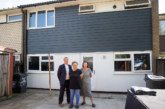The pressure is on for local authorities to improve heating efficiency across their estates to contribute to the UK’s steep 80% emissions reduction target by 2050. Mike Hefford, CHP General Manager at Remeha looks at the challenges and opportunities that lie ahead.
The Government has set a new target of reducing greenhouse gas emissions from across the UK public sector estate by 43% by 2019/20 against 2009/10 levels. So prioritising energy efficiency will undoubtedly top the New Year’s resolutions list for astute estates and facilities managers.
Energy efficiency is a cost-effective, rapid way to reduce carbon emissions, drive down bills and improve energy resilience. Indeed, government anticipates that the more stretching goal will save the public purse an estimated £340m.
Where to start? Improving how we heat our buildings has emerged as the key focus. In its Energy Efficiency 2018 report, the IEA suggests that buildings in 2040 could be nearly 40% more efficient than today — with space heating offering over a quarter of the potential energy savings. The Government has also identified heating as a natural target for improvement.
So far so good. But unfortunately, there’s no single straightforward solution as older buildings and efficiently designed new properties will require very different solutions. Take the electrification of heat, one of the means by which government intends to move to a low carbon future. While electric heating equipment such as heat pumps will increasingly be used in new-build projects, there may not be the budget to upgrade the electricity supplies in older buildings to meet the requirement. Equally, due to the nature of the heating system, higher temperature heating solutions may prove to be more suitable in these buildings.
It’s these older properties that present the real challenge. So what options are available for estate managers? Let’s start with the low-hanging fruit.
Efficiency starts with the boilers
Given that many older buildings still rely on ageing, inefficient boilers for their heating, there is still huge scope for significant energy and emission savings from a low-cost plant upgrade. Replacing dated, inefficient boiler plant with modern, high-efficiency condensing boilers, for example, has the potential to achieve transformational results.
South Ayrshire Council is a case in point. The council reduced the annual gas bill at its County Buildings headquarters by £35K — equivalent to 217t of carbon emissions — after replacing old pressure-jet boilers with Remeha Gas 310/610 Eco Pro boilers.

Such an outcome is far from isolated in our experience, with customers reporting gas usage falling by as much as half after a boiler upgrade. Take Aberystwyth University, where gas consumption dropped by 46% at its William Davies research centre and by 50% in its Penglais student accommodation buildings following a boiler replacement programme. Importantly, an investment in high-efficiency condensing boiler technology not only delivers rapid financial payback, but future operational savings that will help to stretch the straitened budgets.
Hybrid solutions
But what happens when the low hanging fruit has been picked? As we look to decarbonise heat, installing hybrid solutions — where low carbon technologies operate in conjunction with high-efficiency condensing boilers — should be an option during the transitional period to full electrification of heat.
Each building will have its own unique requirements, but manufacturers will be able to advise on the most appropriate solution. For example, in buildings with high demand for electricity and heating and/or hot water, the most effective solution for long-term savings may be to install Combined Heat and Power (CHP) units, with condensing boilers meeting peak demand.
CHP units generate electricity and heat simultaneously onsite in a highly efficient process. Condensing CHP units can reduce primary energy usage by up to 40% and emissions by up to 60% compared with traditional generation. As a result of this ability to generate electricity onsite, CHP can produce lower carbon electricity at lower gas prices to supplement or replace the grid supply.
The greater the ‘spark spread’ — or difference between gas and electricity costs — the greater the savings from a CHP system. With gas prices currently at around a quarter of the cost of electricity, and electricity prices predicted to rise faster than gas, CHP has the potential to deliver considerable financial and environmental benefits in buildings like hospitals, care homes or leisure centres.
Communal heat networks
In multi-occupancy buildings, it’s worth considering adopting heat networks to achieve the most effective solution to more efficient heating. Smaller, communal heat networks that serve one or more buildings with multiple occupants from a central energy plantroom are gaining traction, accounting for 11,500 of the 17,000 heat networks in 2017.
According to the Association of Decentralised Energy (ADE), 54% of energy in the UK is wasted, mainly through heat. A heat network works by utilising renewable or low carbon gas-fired equipment operating on low temperatures to distribute heat to a number of domestic or non-domestic buildings. Together with energy efficiency, electrification and hybrid solutions, the Government has identified heat networks as a key technology to decarbonise heat.
Financial support and guidance are available for local authorities developing heat networks through the Heat Networks Delivery Unit (HNDU) or the Heat Networks Investment Project (HNIP), depending on the project.
While a number of different heat sources can be used in a heat network, a low carbon technology like CHP can dramatically reduce both energy costs and emissions.
The onsite generation process means that smaller scale CHP communal heating schemes can also help balance the peaks and troughs in electricity supply, providing greater energy resilience and security. This coupled with the inherent efficiency losses of centralised generation and distribution, means that CHP can offer real benefits in practice in communal heating schemes.
Bridge to full decarbonisation
80% of UK buildings currently rely on gas for their heating — a figure that is unlikely to change overnight. While full decarbonisation of heat is the end goal, the immediate challenge for estates managers is to improve heating efficiency across their older buildings. Advanced technologies like CHP and condensing boilers provide a practical, cost-effective bridge to low carbon, low cost heat. By implementing technologies like these, local authorities will make important headway in achieving the new emissions reduction target. The route to full decarbonisation of heat starts here.









